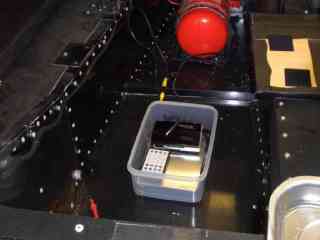| As for the other end of the system, this is all now wired in and the Neuros and its remote safely ensconsed in a Tesco's Value tupperwaresque locking lid lunchbox. Unfortunately when I first tried to power up the system, not a lot happened. This was, I suspect, a result of me having wired up my bodged-together power supply incorrectly. Really quite amazingly incorrectly to be honest, given that I'd mixed up the input and the output which meant that my Neuros II, designed to have 5V gently massaged into it, ended up having a rather unexpectedly vigorous 12V shoved up its silicon backside. Net result, one gently fried Neuros, and a quick eBay session on me to get another one shipped over from the good ol' US of A. Ah well, an early downpayment on this year's stupidity tax bill... |  |